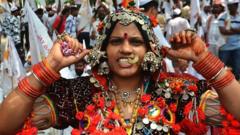Should India Count Castes? Exploring the Pros and Cons

Published: 2025-11-13 01:00:23 | Category: world
The upcoming 2027 national census in India will include a count of every caste for the first time in nearly a century, highlighting the complexities of caste dynamics in the country. This move has sparked significant debate about the implications for government benefits distribution and social justice, with scholars divided on whether it will entrench or dismantle the existing caste hierarchy. Advocates argue that a detailed caste enumeration could improve welfare targeting, while critics warn that it may reinforce discrimination and legitimize caste divisions.
Last updated: 03 October 2023 (BST)
What’s happening now
The Indian government has announced plans to conduct a comprehensive caste count in the 2027 national census, responding to demands from various political parties and states. This decision marks a significant shift after decades of political hesitation regarding caste enumeration, with the last comprehensive caste census conducted in 1931. As India grapples with persistent social inequalities, the forthcoming census aims to provide a clearer understanding of caste dynamics and their implications for government welfare schemes.
Key takeaways
- The 2027 census will include a count of all castes, the first since 1931.
- Advocates see this as a chance to better allocate welfare resources.
- Critics argue it may entrench caste hierarchies rather than dismantle them.
Timeline: how we got here
The push for a caste census has evolved through various political and social movements over the years. Key milestones include:
- 1871: The British colonial administration begins counting castes as a means of control.
- 1931: The last comprehensive caste census is conducted in India.
- 2011: An unofficial survey records over 4.6 million caste names but lacks government verification.
- 2023: The Indian government announces the inclusion of caste in the upcoming census, responding to long-standing demands.
What’s new vs what’s known
New today/this week
The recent announcement of a caste enumeration in the 2027 census represents a pivotal moment in Indian politics, offering the potential for a more accurate portrayal of social inequalities. This move comes after years of lobbying from various political factions and states advocating for a clearer understanding of caste-based demographics.
What was already established
Historically, caste has been a defining feature of social identity in India, shaping access to resources and opportunities. Previous censuses have not addressed caste since 1931, leading to a reliance on outdated data that fails to reflect contemporary realities.
Impact for the UK
Consumers and households
While the caste census is primarily an Indian concern, its implications can resonate globally, including in the UK, where the diaspora may experience similar stratifications. Understanding caste dynamics may influence how social justice issues are viewed and addressed within immigrant communities.
Businesses and jobs
For UK businesses with ties to India, awareness of caste issues may affect hiring practices and corporate social responsibility initiatives, as companies seek to engage with a diverse workforce sensitive to caste dynamics.
Policy and regulation
In the UK, policies addressing social inequality may be informed by India's approach to caste, prompting discussions on how to effectively measure and address disadvantage within minority communities.
Numbers that matter
- 4.6 million: The number of caste names recorded in an unofficial 2011 survey.
- 800 million: The estimated number of Indians relying on government assistance for basic needs.
- 6: The number of caste censuses conducted by British authorities between 1871 and 1931.
Definitions and jargon buster
- Caste: A traditional social hierarchy in India that divides people into distinct groups based on birth and occupation.
- Dalits: A group historically known as "untouchables," representing one of the most oppressed segments of Indian society.
- Adivasis: Indigenous tribespeople in India who often face social and economic marginalization.
- OBCs (Other Backward Classes): A category that includes castes that are considered socially and educationally disadvantaged.
How to think about the next steps
Near term (0–4 weeks)
The immediate focus will be on the preparation for the 2027 census, including discussions on how to effectively implement caste enumeration and collect accurate data.
Medium term (1–6 months)
As the census approaches, political discourse will likely intensify, with parties taking stances on how caste data should inform policy and welfare distribution.
Signals to watch
- Government announcements regarding census methodology and timelines.
- Political debates surrounding caste quotas and affirmative action policies.
- Emerging research on caste dynamics and social justice initiatives.
Practical guidance
Do
- Stay informed about government announcements regarding the caste census.
- Engage in discussions about the implications of caste data on social policy.
- Support initiatives that advocate for equitable distribution of resources based on verified data.
Don’t
- Assume that counting castes will automatically lead to fairer policies.
- Overlook the complexities of caste dynamics in discussions about social justice.
- Neglect the voices of those advocating for the dismantling of caste hierarchies.
Checklist
- Understand your local community's stance on caste issues.
- Follow key political figures and organisations involved in the caste census debate.
- Consider the historical context of caste in shaping contemporary policies.
- Engage with literature and research on caste dynamics and social justice.
- Participate in community forums discussing caste-related issues.
Risks, caveats, and uncertainties
While the intent behind the caste census is to improve welfare distribution, there are significant risks involved. The potential for political exploitation of caste data poses a threat to social cohesion, and the challenge of accurately classifying numerous subgroups within castes complicates the process. Furthermore, the historical context of caste enumeration raises concerns about legitimising existing hierarchies rather than dismantling them. The debate remains contentious, with various stakeholders advocating for different approaches to addressing caste-based inequalities.
Bottom line
The impending caste census in India represents a pivotal moment with the potential to reshape social policies and welfare distribution. However, the complexities of caste dynamics and the historical implications of enumeration raise crucial questions about whether this exercise will entrench or dismantle existing inequalities. As India approaches this significant milestone, the discourse surrounding caste and social justice will undoubtedly evolve.
FAQs
What is the significance of the caste census in India?
The caste census aims to provide a clearer understanding of social inequalities and improve the targeting of government welfare schemes. Advocates argue it could lead to more equitable distribution of resources.
What are the concerns about counting castes?
Critics warn that counting castes may reinforce existing hierarchies and legitimize discrimination, rather than addressing the root causes of social injustice.
How has caste been politicised in India?
Caste has become a focal point in political strategies, influencing welfare policies and electoral dynamics, as various groups lobby for greater representation and benefits based on caste.



